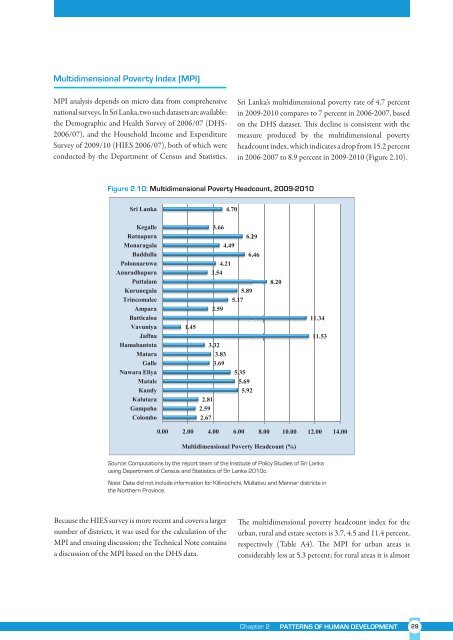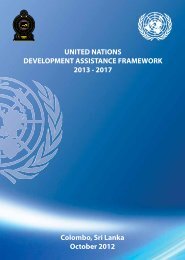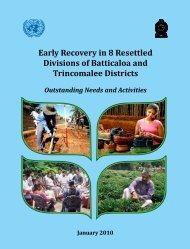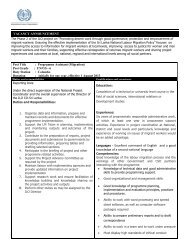Sri Lanka Human Development Report 2012.pdf
Sri Lanka Human Development Report 2012.pdf
Sri Lanka Human Development Report 2012.pdf
You also want an ePaper? Increase the reach of your titles
YUMPU automatically turns print PDFs into web optimized ePapers that Google loves.
Multidimensional Poverty Index (MPI)<br />
MPI analysis depends on micro data from comprehensive<br />
national surveys. In <strong>Sri</strong> <strong>Lanka</strong>, two such datasets are available:<br />
the Demographic and Health Survey of 2006/07 (DHS-<br />
2006/07), and the Household Income and Expenditure<br />
Survey of 2009/10 (HIES 2006/07), both of which were<br />
conducted by the Department of Census and Statistics.<br />
<strong>Sri</strong> <strong>Lanka</strong>’s multidimensional poverty rate of 4.7 percent<br />
in 2009-2010 compares to 7 percent in 2006-2007, based<br />
on the DHS dataset. This decline is consistent with the<br />
measure produced by the multidimensional poverty<br />
headcount index, which indicates a drop from 15.2 percent<br />
in 2006-2007 to 8.9 percent in 2009-2010 (Figure 2.10).<br />
Figure 2.10: Multidimensional Poverty Headcount, 2009-2010<br />
Source: Computations by the report team of the Institute of Policy Studies of <strong>Sri</strong> <strong>Lanka</strong><br />
using Department of Census and Statistics of <strong>Sri</strong> <strong>Lanka</strong> 2010c.<br />
Note: Data did not include information for Killinochchi, Mullativu and Mannar districts in<br />
the Northern Province.<br />
Because the HIES survey is more recent and covers a larger<br />
number of districts, it was used for the calculation of the<br />
MPI and ensuing discussion; the Technical Note contains<br />
a discussion of the MPI based on the DHS data.<br />
The multidimensional poverty headcount index for the<br />
urban, rural and estate sectors is 3.7, 4.5 and 11.4 percent,<br />
respectively (Table A4). The MPI for urban areas is<br />
considerably less at 5.3 percent; for rural areas it is almost<br />
Chapter 2 Patterns of <strong>Human</strong> <strong>Development</strong> 29






